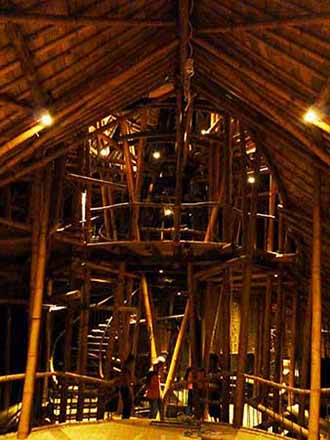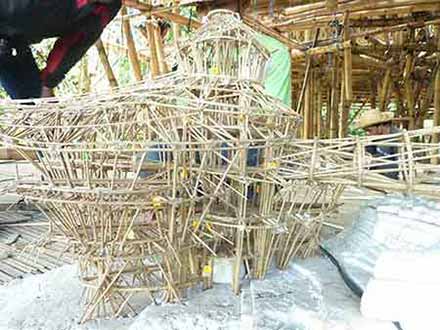Building Construction Using Bamboo Part 2
Designing and Constructing Buildings From Bamboo
How do we design bamboo buildings and how do we construct using joined, woven or laminated bamboo for structures, floors walls and roofs.
See also:

How to Use Bamboo in Building Construction
Last issue we looked at bamboo, a material even more versatile than duct tape. We also looked at how bamboo is cut, handled and treated to make it last a long time.
For eons of time the Balinese have used bamboo for building construction finding it cheap, plentiful and easy to work. Their structures tend to be functional and of standard rectangular forms with vertical walls and pitched roofs.
In recent years, however, some very creative people have been developing amazing free flowing designs in which rectangles are rare.
Bamboo Design Considerations
First let us look at some important design considerations.
When building with bamboo it is important to:
- Avoid direct contact with the ground.
- Keep it out of the rain (except roofs of course).
- Provide adequate drainage around the building to keep the area as dry as possible.
- Provide adequate ventilation in the building.
Building design needs to support these factors and where possible use extended roofs that protect the walls and structure from direct sun and rain.
Joining bamboo
Another important design consideration is how the bamboo is joined. Traditional methods involve the use of bamboo pegs and coarse twine made from coconut fibres. There are some fairly sophisticated jointing methods around these days but contemporary construction often involves the use of bolts through bamboo sections filled with concrete.
Bamboo can be used for building in various different forms. In construction it can be used in its natural tubular form for beams, columns and supports.
Bamboo can be split down its length and flattened out to form long narrow sheets. These are widely used for walls, floor surfacing and, more recently, roofing.
Woven Bamboo
Bamboo can also be split into thin strips that are woven into sheets known as gedeg and used for walls, ceilings, blinds and furniture. Some forms of gedeg can be very fine and may have patterns woven into them using different colours of bamboo.
Laminating Bamboo
Bamboo can also be laminated and this opens up considerably more useful applications. To laminate bamboo it is accurately machined (to engineering rather than carpentry levels of accuracy) then glued together and clamped tightly until the glue has set. This gives a very dense and heavy material that can be used as a replacement for wood for such things as window and door frames, doors, flooring, furniture, etc. It can even be used for large structural beams in buildings.
Laminating from strips also makes it possible to laminate curved or arched beams opening up design possibilities for creative architects. The strips individually bend easily but once laminated into curves the bamboo becomes rigid and very strong. The glue commonly used for laminating is PVA glue, the type widely used by woodworkers.
For some uses bamboo can be cut fairly roughly and 'stitched' together using long dowels (rods). This is a very effective way of making flooring panels, steps or shelves.
Bamboo has been used for roof frames since time immoral. It is strong, fairly light in weight and flexes which allows it to absorb shock loadings which is very useful for resisting strong winds, earthquakes or 10 year old boys.
Bamboo Roofs
Probably one of the least acknowledged uses for bamboo is for roof coverings. In the area around the traditional village of Penglipuran near Bangli you will find roofs covered with bamboo shingles. Some are quite thick and nailed in place while others are much thinner and woven together at their upper ends rather like alang alang.
In other places you can find roofs covered with bamboo that has been split into halves and simply laid down to form a sloping roof.
More recently we are seeing flattened bamboo used rather like roof tiles, this can be very effective when used with a thick layer of aluminium insulation underneath it.
Bamboo Flooring
High quality wooden flooring is beautiful but is rapidly moving out of reach of the pockets of ordinary folk. Teak, for example, is an excellent flooring wood but, due to high costs, people are seeking alternatives.
Laminated bamboo is being increasingly used to make flooring panels. Bamboo is hard and wear resistant (though not as hard as a good hardwood of course) and has a warm natural look and feel. To make floor panels it is necessary to cut the bamboo into strips and glue them together with several layers set at right angles (the technique used to make plywood). Setting the grain crossed in this way makes the panels both strong and very stable.
Bamboo for Doors and Windows
Laminated bamboo can be used to make beautiful doors but they can be very heavy and it is a good idea to use a honeycomb interior with laminated surfaces to reduce the weight.
Door and window frames can also be made from bamboo. The bamboo is laminated to make up lengths which are then cut and planed in the same way that wood is used. External windows get a lot of punishment from the weather and it is important to make sure the bamboo is well varnished and that the varnish is kept in good condition.
Panels for insulation, soundproofing or wall fill can be made using bamboo shavings mixed with cement.
The Design of Bamboo Buildings
So what about design? A good question. It's very difficult to describe what is being achieved and all I can do is suggest that you go and have a look. Bali is probably one of the best places in the world to see bamboo buildings.
Linda Garland's well known bamboo house started it all many years ago and can be seen at her estate which is now known as Panchoran Retreat situated just South of Ubud.
John Hardy is a pioneer with a passion in the use of bamboo. He is the driving force that set up the Green School in the Sibang area near Mambal, an amazing creation and the realisation of a very ambitious vision. The immense 3 storey Heart of School building is surrounded by 20 or 30 other buildings all built from bamboo. The school also features two bamboo bridges across the Ayung River. Every use for bamboo imaginable has been demonstrated at the Green School and the architecture is stunning.
The experts for building with bamboo are PT Bamboo Pure whose factory is close to the Green School. PT Bamboo Pure design and construct architectural masterpieces and have built Green Village, a complex of bamboo houses quite close to the Green School.
Designing Bamboo Buildings
These houses really are works of art, they are also serious buildings, their latest creation is five stories high. The creative genius behind the design team is Elora Hardy who uses a construction process very different from conventional approaches to building construction. This is due to the fact that the buildings are complex 3 dimensional structures that simply cannot be fully documented on paper.

Initial concept sketches lead to working drawings which are developed as far as is practicable. From the drawings 3 dimensional scale models are built which are then used as patterns to build the buildings themselves. Even then the structures evolve with a constant process of design as construction proceeds. It is a highly intensive design process and very labour intensive but the results are truly spectacular with every element of each building a work of art in itself. Conventional design concepts or building techniques simply don't feature in these structures.
Green Village
Green Village is a showcase of what can be achieved with bamboo and demonstrates the fact that we are limited only by our imagination.
PT Bamboo Pure also supply correctly treated bamboo in many forms, poles of different species and sizes, flattened bamboo, bamboo flooring panels and split bamboo for weaving walls and ceilings.
Bamboo Chocolate factory - One of the world's largest bamboo buildings
Another building of note is the chocolate factory also situated in the Sibang area. The dream of Ben Ripple this a more conventional building design but is noteworthy because of its shear size, it is probably one of the world's largest bamboo structures. It is well worth a visit and don't forget to sample the chocolate.
If you look around you will see many more bamboo buildings around Bali, both traditional and contemporary, too numerous to mention. All over the island there is a constant process of building temporary bamboo structures, holding amazing ceremonies then knocking them down again. It is just part of the natural flow of life in Bali.
See also:
Phil Wilson
Copyright © Phil Wilson October 2013
This article, or any part of it, cannot be copied or reproduced without permission from the copyright owner.
